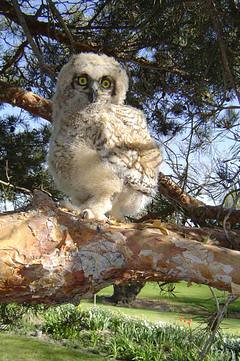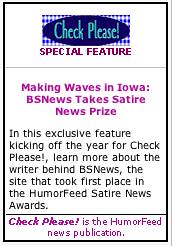Technics: Theory - content/semiotics distinction? 'Feedburner' by John Heileman, Business 2.0, layered semiotically as free ad
. - Anaximaximum and Owlie Scowlie Further Resources:
I just came across an article, "Redefining the RSS feed––FeedBurner CEO Dick Costolo tells Business 2.0 Magazine how he plans to put his stamp on the Wild West medium of RSS," by John Heilemann, the article appearing online in Business 2.0 Magazine (June 27,2k6). I became enchanted by the content, and at the same time I thawt of the discourse intextated without inline visuals or live-links as a perfect occasion for visual-enrichment and hypertexting (more radically, I'm interested in the phenom of hyperwording). Even the more limited project of vis-enrich / hypertexting with live-links can not be done all at once (by me). The first new layer––being a visually-enriched second layer and taking the semiotic-semantic significance to a h+er, more complex level than Heilemann in Biz2.0––has already been added by my co-composer Anaximaximum and myself, Owlie Scowlie, for this blog entry. In the immediate case, we're your refWrite team for this semiotically-experimental blog-entry which has already undergone three drafts, and is now being left to dry. It includes hypertext language markup (HTML) in the form of common semiotic devices, that overlap one another in meaning (semantic-grammatical import) where the accumulation of signs can no longer be taken for granted as individual marks for emphasis––for instance, emphasis of acronyms, or individual words more largely, or phrases. In this second semiotic layer also, some URL's make visible links that connect you live whenever you click your cursor on one or another of them (these will be built up over time in this blog-entry), each of the visible live-links taking you away to yet another imaginal /rather, virtual/ universe of some other webpage, probably at some other blogsite / website.
The text below is semiotically-treated by A and OS, as a semiotics analysis / experiment that is derived from a Business 2.0 Magazine magazine article by John Heilemann as mentioned above. Here's Heilemann's plain text with some "second level" semiotic enrichment:Mention to Dick Costolo that, for most of this generation's Web startups, getting funded has been a snap, and he emits a rueful laugh. "Not for us," recalls the CEO of the content syndication outfit FeedBurner. "Most venture capitalists we met couldn't spell RSS - let alone understand it."
![]()
That was in 2004, and Costolo and his three co-founders were toiling in obscurity in their Windy City headquarters. "I don't know how many times we heard, 'We like you guys, but you're in Chicago,'" Costolo says. "Which really meant 'We don't get it.'"
Two and a half years later, a lot more people get it - as FeedBurner's meteoric rise vividly demonstrates. Today the company manages more than 300,000 feeds that use the RSS (really simple syndication) format or a variant thereof, and its customers range from the humblest bloggers to the mightiest publishers: Gannett (Charts), Hearst, Reuters.
Though its success so far has yielded little revenue (and not a dime of profit), the company is now backed by several of the media-savviest [Venture Capitalists] VCs in the business.
What the moneymen believe is that FeedBurner is in the vanguard of the creation of a brand-new medium. And while, God knows, talk like that is cheap, I think they may be right.
The return of "push technology"
Semiote Analytics & Experiment, by Anaximaxium:
Before explaining why that's so, it might be helpful (at least for the uninitiated) to start with the ABCs of feeds. RSS is what used to be called a "push" technology: It lets publishers stream Web content instantly to users who've subscribed to their feeds, and lets users keep up with a large number of sites without having to check them manually.
When new content is posted on a site, subscribers are notified and sent either full versions or summaries of the fresh material (along with links back to the site), which they can read inside what's known as an aggregator, such as NewsGator's FeedDemon [for Windows - Owlie Scowlie]. (Both Firefox and Apple's Safari browser have built-in feed readers.)[But, sad to say, the last mentioned feature of Safari doesn't make up for that browser's lacks and snags. You're better advised to switch to Firefox 1.5 and a wee h+ier (1.5.0.4), with some really fine "plug-in" extensions (or "add-ons") available - Blogger Web Comments, Linkification, and the jetsetting Greasemonkey for trying JavaScripts for yet other Firefox browser add-ons. – Owlie Scowlie].
Technotes, by Owlie Scowlie
RSS began to take off roughly three years ago - and that's when Costolo, then 39 and the founder of two previous startups with the same three partners, saw an opening.
"We thought, if this gets big, it's going to be impossible for content producers to manage," he remembers. "We'll say to publishers, 'Hand us your content to syndicate - we'll run your feeds and provide you a detailed picture of how many subscribers you have, what's being read, where the feeds are going. Then we'll help you monetize them by stapling ads to them.'"
When FeedBurner launched in February 2004, it was instantly popular with bloggers. But commercial publishers were wary, if not outright dismissive."They'd say, 'I only care about feeds in that they drive traffic back to my site,'" Costolo reports. So he reminded the publishers of what happened when the Web boom began. "They tried to use their sites to drive subscriptions to their print products," Costolo says. "I said, 'How'd that work out for you? The new medium never drives dollars to the old; it drives dollars to the new thing.'"
[Inserted enumeration below: A.), B.), C.) with bracketed stuff of mine - Owlie Scowlie: ]
Like the Web 10 years ago, he argued, feeds had reached a tipping point. "You can't stop this train," he told them. "Content is going to be syndicated and consumed all over the place. Your job is to figure out how to turn that into an opportunity."
Incorporating advertising
Crucial to convincing the publishers was that Costolo offered to run their feeds and provide them with subscriber data for free. What they saw when they looked at the data was that "hits to their feeds were going up, up, up, while traffic back to their sites wasn't going up as significantly," Costolo says. "That caused a lot of them to say, 'Shit, there's a lot of money that I'm not making out there on the edges.'"
All along, Costolo thought advertising was the way for publishers to begin to rake in that dough. Initially the company had planned to splice ads from various ad networks into the feeds it manages, taking a cut of the revenue, typically 35 percent.
But Costolo's team soon decided that it made more sense to build [RSS']s own ad network - and one that places ads not just in feeds but also on the publishers' websites. (Such ads, Costolo says, will be "feed-driven." Unlike, say, ads placed through Google's AdSense network, which are typically in a column far away from the post containing the targeted keyword, FeedBurner's will be tightly linked to specific items and positioned in the middle of the page, right under the relevant post.)
With its burgeoning ad network, FeedBurner may be hurling itself into the lion's mouth. As a manager of feeds, the company has no equal.
But as an ad network, it will be in competition with Google (Charts), as well as Yahoo (Charts – music and stocks), AOL, Blogads, ValueClick, and others. Costolo recalls that when he was seeking VC cash, the specter of Google was often raised.
He dismissed it then, but no longer. "I've come around to the view that Google will eventually start managing feeds and monetizing feeds as another way to promote AdSense," he concedes.
Staring down Google
Yet Costolo views the prospect of tangling with Google with striking equanimity. "We have to leverage our critical mass of publishers to create network effects," he says. As an example, Costolo cites plans to allow publishers in the network to form "affinity groups" by blending their feeds together.He mentions the possibility that
[here's a handful of said liberal political blogs, tho I don't know how "popular" they are - OS]
A.) Daily Kos,
[An extreme leftwing blog, main rallying point of extreme left in Democratic Party where the ever-leftier prez-election-loser John Kerry and nomination-as-candidate loser Howard Deane, now National Democratic Party's Chairman are both lionized, or is it eagle-ized? legalized? - Owlie Scowlie]
B.) Talking Points Memo,
[An extreme leftwing blog, main rallying point of extreme left in Democratic Party where the ever-leftier prez-election-loser John Kerry and nomination-as-candidate loser Howard Deane, now National Democratic Party's Chairman are both lionized, or is it eagle-ized? legalized? - Owlie Scowlie]
and C.) a handful of other popular liberal political blogs• 1.) The Plank
The foregoing alteration, not so much of the textual content but of the semiotic interpretive overlay, at first confined just to what we're calling Level 2 (bolds, underlines, and live-links together) give an accumulated result that alters the graphic experience of the page, hence also of the text.
• 2.) The Arkansas Blog
• 3.) The Online Beat [blog via The Nation]
• 4.) The Notion [blog via The Nation]
• 5.) Editor's Cut [blog via The Nation</a>
might offer a joint feed - leading lefty readers to subscribe to that feed rather than to each individually.
"Then the incentive for all of them would be high to stay in FeedBurner," Costolo says, "because as part of the liberal politics feed, they'd be reaching more people than they would on their own."
Costolo's confidence about fending off Google and other potential rivals also owes to FeedBurner's head start in a market that's racing forward at lightning speed. "For RSS, 2004 was all about blogs, 2005 was all about text publishers, and 2006 is shaping up as the year of audio and video," he says.
Already Apple (Charts -- The Human Body Project and AAPL financial chart [Yahoo! Finance]) has harnessed RSS to potent effect in its iTunes Music Store, which offers thousands of audio and video podcasts for download, each of them powered by a feed.
And although Costolo won't name the companies, he says two entertainment giants are about to start using FeedBurner to drive consumers to social media venues such as MySpace. "Hollywood sees how feeds can contribute to the ecosystem of exposure," Costolo observes.
And FeedBurner intends to make that ecosystem even more complex. For some time the company has been developing a feed-splicing tool to let users create what Costolo calls a "personal content network" - a "feed of me."
"You put your tags in Del.icio.us, ![]() your photos in
your photos in ![]() , your friends in
, your friends in  ; you have a blog
; you have a blog ![]() , a podcast [not yet! - OS], etc.," he says. "And we splice it all together into a single feed."
, a podcast [not yet! - OS], etc.," he says. "And we splice it all together into a single feed."
There are, of course, plenty of folks with personal websites. But with a "feed of me," subscribers would be able to track changes in your data at the atomic level - being notified instantly when you add a new photo set or playlist, not just when you update your site.
More important, developers could build new applications to display and manipulate all that data, leading to vast new possibilities for advertising and marketing.
All of which is why I like Costolo's chances in any future battle over this virgin turf - even, dare I say it, with Google. What the guys at FeedBurner understand is that RSS is a brand-new medium, as distinct from the Web as the Web is from newspapers, radio, and TV.
It will be consumed differently and will operate by rules that are foreign not just to traditional publishers but to the titans of the Web. Costolo and his crew don't have all the answers about where this revolution is headed.
But they're asking questions that no one else has even thought of, and that's no small advantage.
- John Heilemann wrote "Pride Before the Fall." His next book is "The Valley." He lives in Brooklyn.
How FeedBurner Works
1 Publishing software is used to create a standard RSS feed.
2 FeedBurner takes the feed and repackages it, making it easier ...
3 ... for advertisers to insert ads wherever the feed appears.
... for consumers to subscribe to it by email, on the Web, or infeed-reading software.
... for the publisher to track the size of his feed audience.

 >br>
>br>









No comments:
Post a Comment